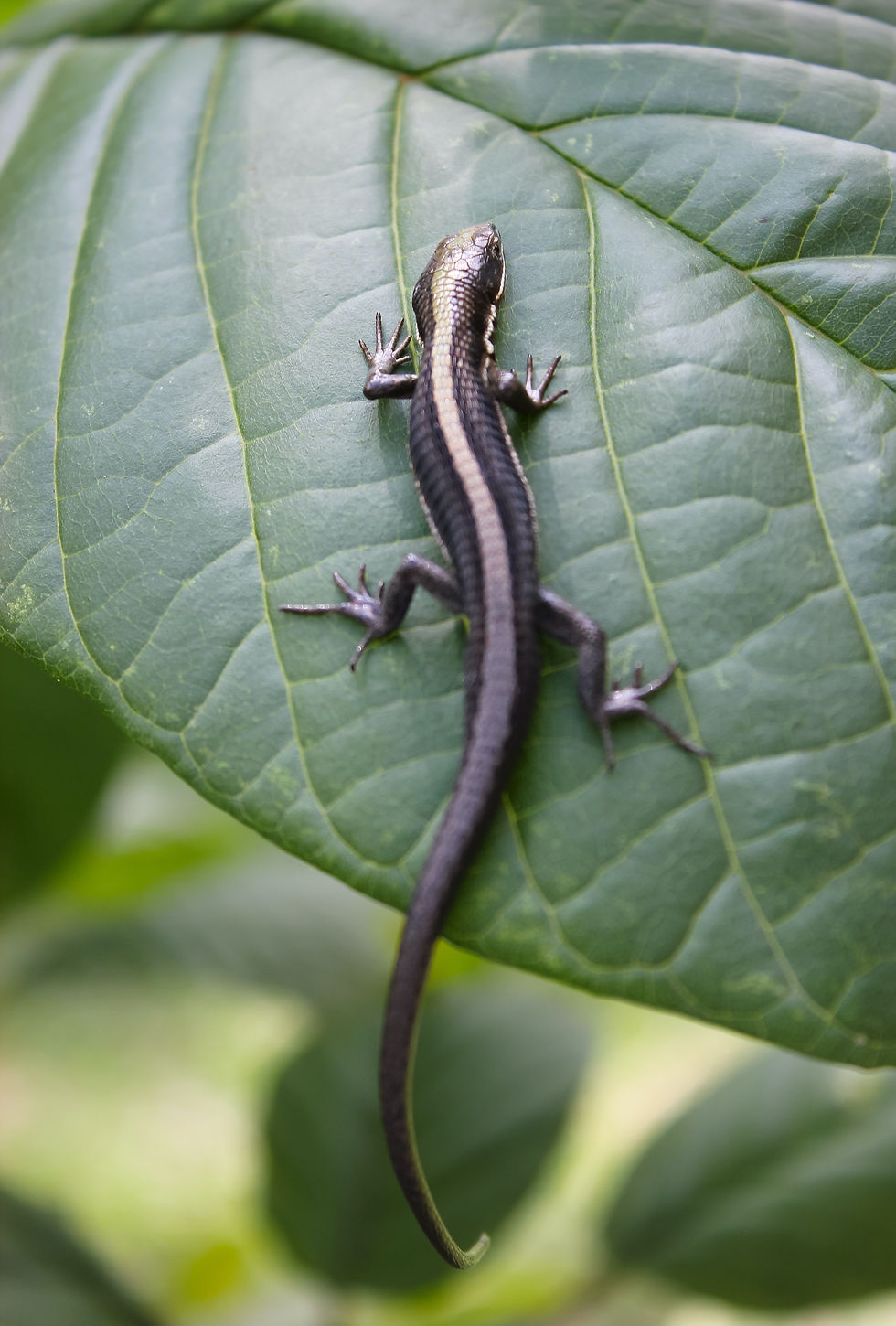Walk Softly - Salamanders & Newts: enigmatic creatures
- Geoff Carpentier

- Apr 10, 2024
- 3 min read

By Geoff Carpentier
I love to watch these elusive amphibians, as they forage through varied watery habitats. This may be in the form of puddles or wetlands, but sometimes can simply be a small amount of water trapped in the folds of a leaf.
Locally, we have 14 species of amphibians, four salamanders and 10 frogs. Salamanders, in general, are a family of animals which undergo a dramatic metamorphosis as they mature. Which is to say, young salamanders do not look like adults nor are they morphologically identical either. The four species of salamanders which occur in our area (i.e. Blue-spotted, Eastern Red-backed & Spotted Salamanders and Red-spotted Newt) are an interesting complex, so let’s explore their lives a bit.
The Blue-spotted Salamander is a forest dwelling animal who can live in deciduous, coniferous or mixed woodlands. The adults spend their time on the forest floor or underground in burrows, where they will also over-winter. Breeding takes place in woodland pools, in the early spring, as they move to their breeding sites on rainy nights. The female will lay 200-500 eggs, in small underwater masses, often attached to twigs. 21 to 28 days later, the young hatch and grow rapidly until mid-summer, when they transform into adults. The larvae first breathe though gills, but absorb these structures and breathe via their lungs when they transform. Food is primarily protein-based, as they are carnivorous. There is a complicated genetic relationship between this species and the very similar, endangered Jefferson’s Salamander, but that’s a story for another day.
The Eastern Red-backed Salamander is uncommon in Durham but numerous in some other parts of the province. Most of our specimens, locally, are grayish with a rusty, pink or red line down the back. However, some individuals come in a different colour morph, whereby it lacks the dorsal stripe and appears solid blackish or gray.
Preferring mature deciduous and mixed forests, it requires many fallen logs and leaf litter for shelter and prey harborage. Overwintering occurs underground or in large ant mounds.
At two years of age, they breed, primarily in the autumn but also occasionally in the spring. The female lays 4 - 17 eggs, in early summer, in a rotting stump or log, unlike any other Ontario amphibians which all lay eggs in water. Red-backed Salamanders do not have a larval stage but hatch as miniature adults. The female tends the eggs for six to eight weeks and, once they hatch, she watches over them for another one to three weeks then they’re on their own.
The third species of salamander found here, the Spotted Salamander, is long-lived (i.e. 15-30 years) and larger than the rest. It is black in colour and is strikingly covered in yellow or orange spots! Deciduous and mixed forests, near ponds, are favoured, as they breed in non-permanent, fish-free waters. They lay 250 eggs in large mats, very early in the spring. The eggs hatch in 30 - 40 days and the tiny larvae live in the water, for two to three additional months. At which time, they become terrestrial adults and live underground or under logs, coming out at night to hunt.
Finally, the Red-spotted Newt lives as an adult in slow-moving water, like ponds, swamps and lakes. 200 to 450 eggs are laid annually, on submerged vegetation, where the eggs hatch in two to four weeks.
The young start out as aquatic larvae which morph into terrestrial immature salamanders, called red efts, and then they return to the water as adults. They remain in the eft stage for normally two years, but can for up to seven years, when they become sexually mature. Both adults and young spend the winter on land in logs, under rock piles or in leaf litter, generally.
Their food is primarily insect/invertebrate focused, as in the other species. Interestingly, they are toxic to most predators, except to garter snakes, so predators shun them as a food source.
One of the greatest threats to all salamanders is the need for high-quality water sources, since they absorb water, oxygen and nutrients through their skin. I want to give a shout-out to James Kamstra, a local amphibian expert, for his help in researching this and the next two columns on frogs of our area.
Geoff Carpentier is a published author, expedition guide and environmental consultant. Visit Geoff on-line on LinkedIn, Facebook and Instagram.








代发外链 提权重点击找我;
google外链发布 google外链;
Fortune Tiger…
Fortune Tiger…
谷歌蜘蛛池/ 谷歌蜘蛛池;
币圈推广 币圈推广;
谷歌霸屏 谷歌霸屏
蜘蛛池 蜘蛛池
谷歌快排 谷歌快排
Google外链 Google外链
谷歌留痕 谷歌留痕
Gái Gọi…
Gái Gọi…
Dịch Vụ…
谷歌霸屏 谷歌霸屏
负面删除 负面删除
币圈推广 币圈推广
Google权重提升 Google权重提升
Google外链 Google外链
google留痕 google留痕
google seo…
03topgame 03topgame;
gamesimes gamesimes;
Fortune Tiger…
Fortune Tiger…
Fortune Tiger…
EPS Machine…
EPS Machine…
seo seo;
betwin betwin;
777 777;
slots slots;
Fortune Tiger…
seo优化 SEO优化;
bet bet;
무료카지노 무료카지노;
무료카지노 무료카지노;
google 优化 seo技术+jingcheng-seo.com+秒收录;
Fortune Tiger Fortune Tiger;
Fortune Tiger Fortune Tiger;
Fortune Tiger Slots Fortune…
站群/ 站群
gamesimes gamesimes;
03topgame 03topgame
EPS Machine EPS Cutting…
EPS Machine EPS and…
EPP Machine EPP Shape…
Fortune Tiger Fortune Tiger;
EPS Machine EPS and…
betwin betwin;
777 777;
slots slots;
Fortune Tiger Fortune Tiger;
google 优化 seo技术+jingcheng-seo.com+秒收录;
谷歌seo优化 谷歌SEO优化+外链发布+权重提升;
Fortune Tiger Fortune Tiger;
Fortune Tiger Fortune Tiger;
Fortune Tiger Fortune Tiger;
Fortune Tiger Slots Fortune…
gamesimes gamesimes;
站群/ 站群
03topgame 03topgame
betwin betwin;
777 777;
slots slots;
Fortune Tiger Fortune Tiger;
google seo google seo技术飞机TG-cheng716051;
03topgame 03topgame
Jogos JOGOS
Fortune Tiger Fortune Tiger;
Fortune Tiger Slots Fortune Tiger…
Fortune Tiger Fortune Tiger;
EPS машины EPS машины;
Fortune Tiger Fortune Tiger;
EPS Machine EPS Cutting Machine;
EPS Machine EPS and EPP…
EPP Machine EPP Shape Moulding…
EPS Machine EPS and EPP…
EPTU Machine ETPU Moulding Machine
EPS Machine EPS Cutting Machine;